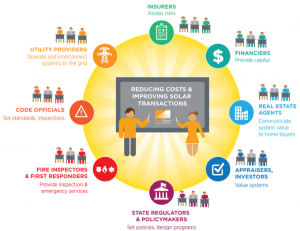According to the research report “Los Angeles Solar: Now and into the Future”, city utilities must overcome implementation challenges in order to continue the growth of solar energy. The report, commissioned by the Los Angeles Business Council Institute, finds that the Los Angeles Department of Water and Power (LADWP) has the opportunity to wean itself from polluting coal-fired power – currently 42 percent of its energy portfolio – and expand the amount of local solar to 1,500 megawatts annually.
Researchers from UCLA’s Luskin Center for Innovation and the USC Program for Environmental and Regional Equity (PERE), found that a program of this scale would also be an economic catalyst, creating thousands of new solar-related jobs and attracting significant long-term investment to Los Angeles. The report cites three strategies in which solar expansion can be achieved: net metering, Feed-in Tariff (FiT) program and the Community Solar Initiative. The FiT can play a lead role, according to the researchers. This program, launched in 2012, enables local commercial property owners to sell solar power generated from rooftops and parking lots back to LADWP at a competitive fixed rate.
 To date, LADWP has authorized 100 MWof power under the FiT program; however, only 6.5 MW are operational, according to the UCLA/USC study. Another 8.2 MW of projects are under contract and awaiting construction, with another 56 MW in the contracting stage. The FiT evaluation concludes that LADWP needs to build its staff resources and continue streamlining the application and installation processes to speed the pace of approving local solar projects if it is to reach a self-imposed deadline to be coal-free by 2025.
To date, LADWP has authorized 100 MWof power under the FiT program; however, only 6.5 MW are operational, according to the UCLA/USC study. Another 8.2 MW of projects are under contract and awaiting construction, with another 56 MW in the contracting stage. The FiT evaluation concludes that LADWP needs to build its staff resources and continue streamlining the application and installation processes to speed the pace of approving local solar projects if it is to reach a self-imposed deadline to be coal-free by 2025.
Spearheaded by the Los Angeles Business Council Institute and the CLEAN LA Solar Coalition, the FiT program provides an opportunity for the LADWP to access the abundant solar energy available on more than 10,000 acres of rooftops in Los Angeles. More than 40 percent of the projects in the FiT’s first three 20 MW tranches are located in “solar equity hotspots” – neighborhoods with abundant rooftops and great need for economic investment and jobs. The hotspot areas exist in the San Fernando Valley, East Los Angeles, and areas west of Downtown, including Hollywood. In many cases, solar training programs that target less advantaged workers, such as participants in Homeboy Industries’ Solar Panel Training and Installation program, are located in or near the hotspot areas.
“Los Angeles has a unique confluence of characteristics providing a firm foundation for a successful solar FiT program: abundant sunshine, a trained workforce and tremendous economic need,” said Dr. Manuel Pastor, Director of the USC Program for Environmental and Regional Equity. “Growing the FiT will bring economic opportunity to some of our city’s most underserved and environmentally-challenged neighborhoods. There’s no question that the FiT can advance solar-related equity goals where they’re needed most.”Read More










